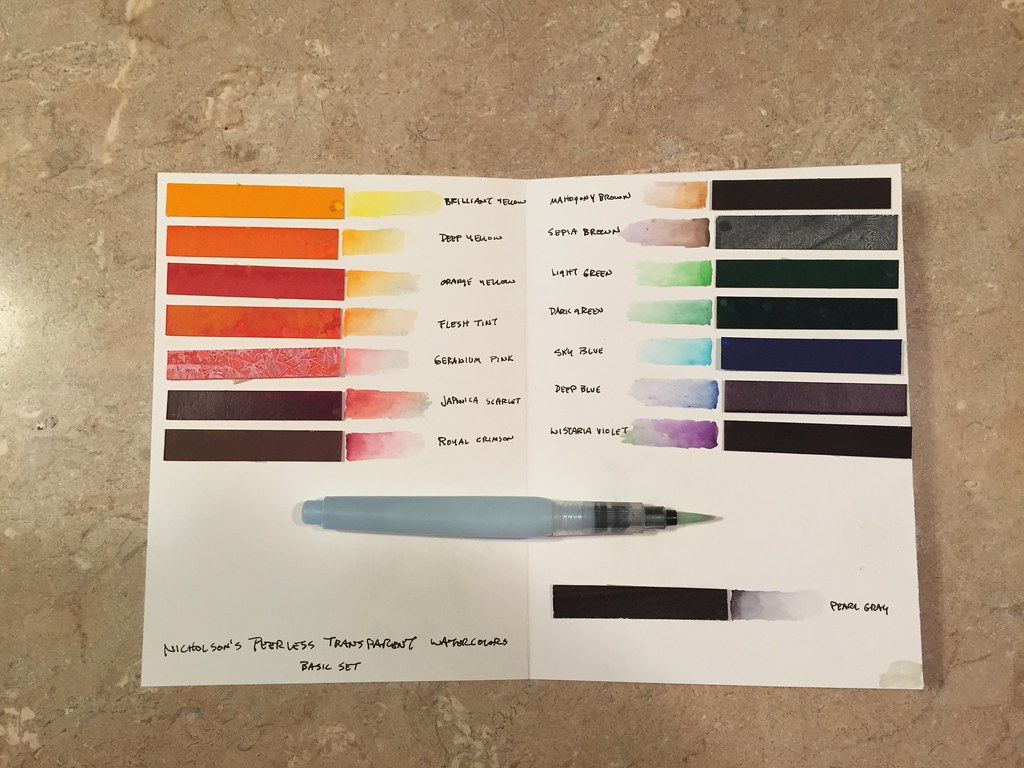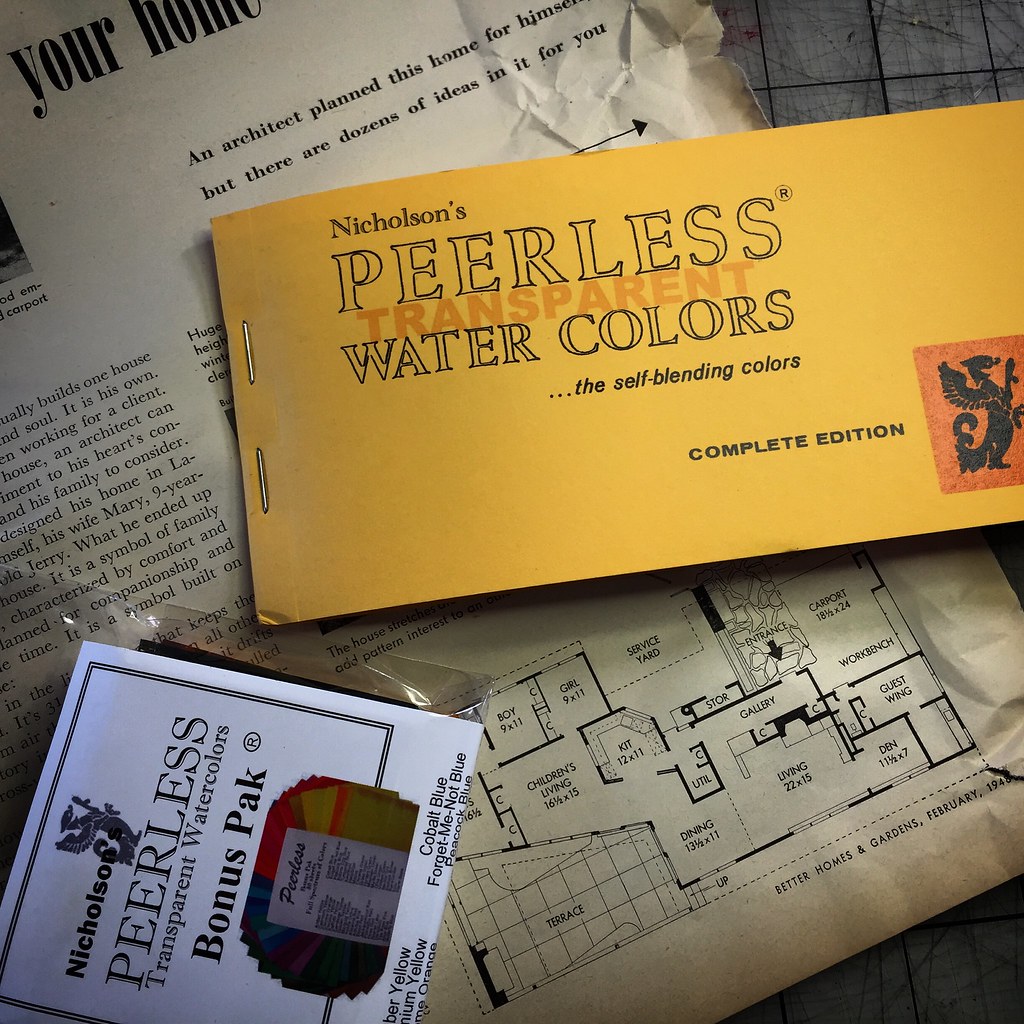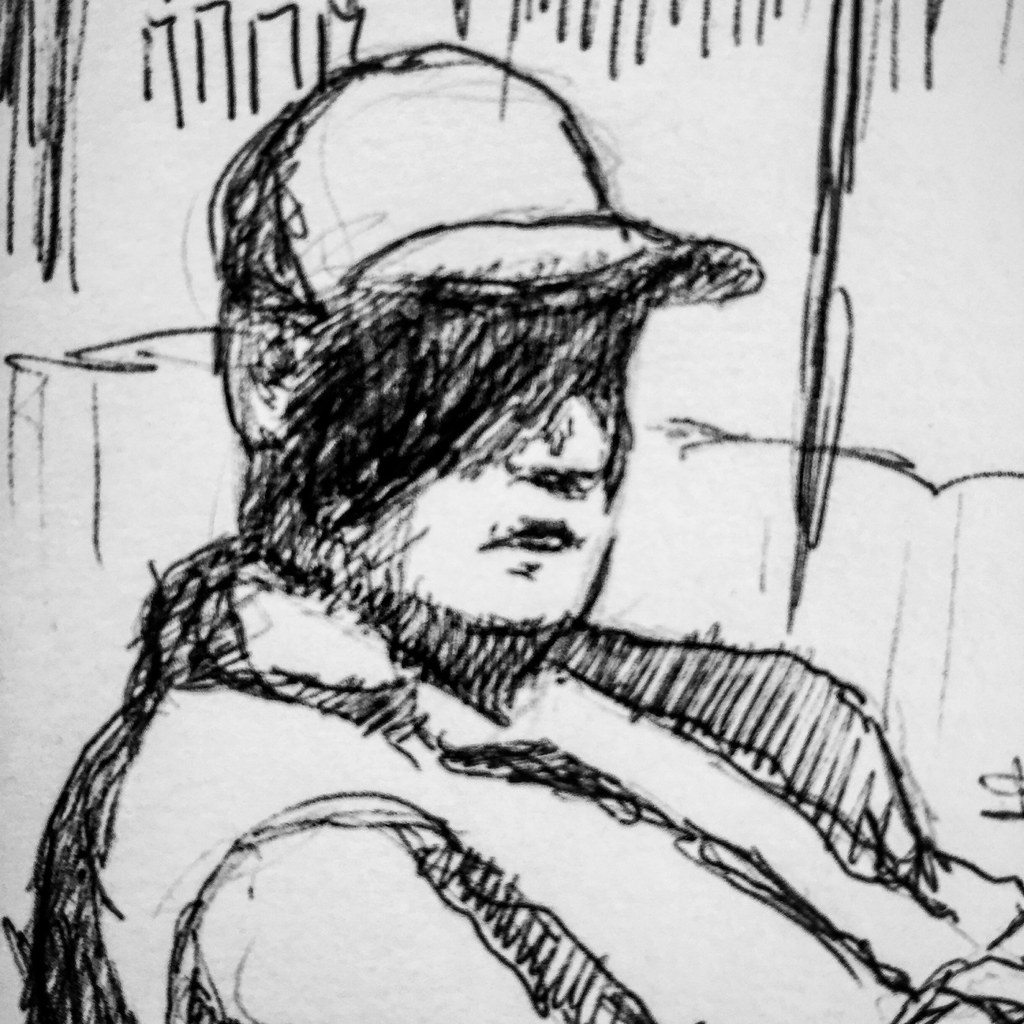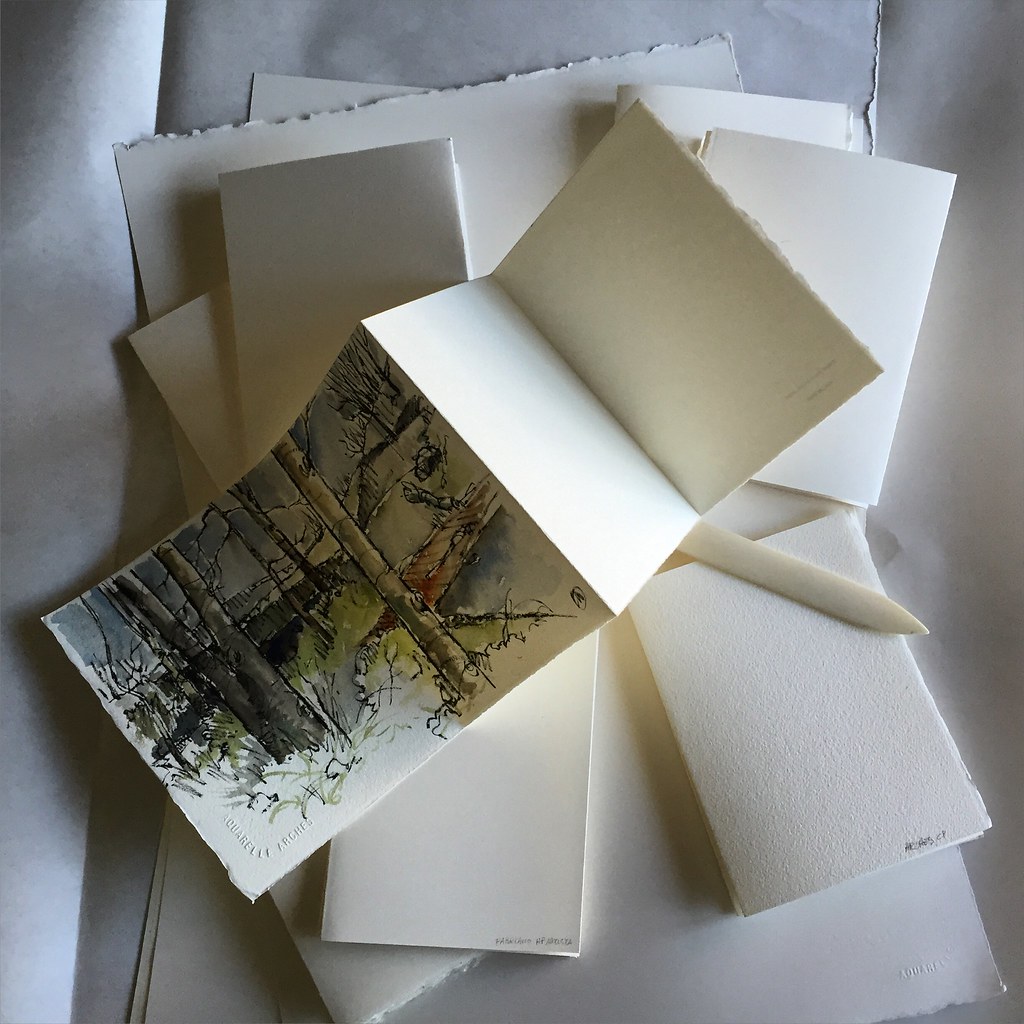By Mark Alan Anderson | Liberty, Missouri
Marcia’s recent post about new tools got me thinking. Like
many artists, I like experimenting with different drawing instruments and
papers. I firmly believe that artists should work with the best materials they
can afford – clearly, there’s a dramatic difference between the pigments in
student grade paint and professional level stuff. But too often my students
fool themselves into believing that expensive tools somehow equal “better”
artwork. I’m a frugal guy (translation: cheapskate.) I need to justify “upgrading”
those tools of mine that otherwise work just fine.
For instance, my lead holder. More expensive than a No. 2
Ticonderoga pencil (which I also keep ready to hand), but it’s lasted me
thirty-five years and I see no reason to believe it won’t continue to work just
fine at least that much longer. It’s a humble drawing tool.
Recently I rediscovered an old favorite, Nicholson’s
Peerless Transparent Watercolors – definitely a humble artist tool, if there
every was one. Rather than in tubes or half pans, these fifteen intense
pigments are on individual sheets of card stock within a small pamphlet. While
there seems to be many approaches to creating a palette of these paints, I
simply snip off a half inch wide section and double stick it to a folded card.
The card fits neatly into my
sketchbook. The paint is activated with a dot of water, so brush pens are a
perfect companion. (And talk about compact: a couple pens fit into a breast
pocket and the sketchbook into my hip pocket.)

I’ve taped a piece of Yupo to the right hand side of the
card stock (not shown) so that the palette winds up being a tri-fold
configuration. The Yupo is an easily washed mixing surface.
And best of all, this incredibly simple kit has rich,
intense colors – it doesn’t take much!
Last year one of my advanced drawing students began to
experiment with ball point pens. Really, just a plain old Bic pen with black
ink. I think they cost something like 59 cents...and the drawings were lovely, sensitive portraits! Plus, it turns out the ink is permanent.
With a little practice one can produce nice tonal variations, and the ink likes
to flow if one uses the medium point pen. I like Bic pens on nice, soft, white,
cottony papers. (Be advised that not all pens are alike. I’ve had poor results
with roller ball pens – and don’t get me started on “gel” pens! Bic seems to be
the best option.)
I also like making my own sketch books and sketch “booklets.”
I don’t really save money doing this, but I do wind up with the paper I prefer.
A couple of weeks ago I engaged in a little action research by testing out
various watercolor papers. I wanted a surface that would work well with my
Pentel Pocket Brush Pen, and would also produce good washes of color. My
watercolor paper of choice has been Arches Cold Press for many years, but it
doesn’t play nicely with the Pentel. So I made booklets up from various sheets
of Arches and Fabriano Hot Press.
I should explain that one sheet of 22 x 30 inch watercolor
paper costs between three and five bucks, and that I get four booklets of four
pages (eight if you use both sides of the sheet) from each sheet of watercolor
paper. My goal was to discover which paper best met my needs. (The winner, by
the way, turned out to Fabriano Artistico Hot Press, but I have yet to try the
Strathmore Aquarius II sheet that Marc Taro Holmes recommends for this same
purpose. So stay tuned!)







What a wealth of information and GREAT tips, Mark! I'm going to run upstairs now and find my Peerless Watercolor booklet that I've had for 7 years but never bonded with. Can't wait to try your suggestion. BTW Guy Moll from southern Portugal who I met at the Lisbon USk Symposium several years ago uses ball point pen for great results. I think bic is his favorite. Here's one; https://flic.kr/p/ECCp4r
ReplyDeleteMarcia, I recall working with Bic pens when I was a Freshman in high school in the early 70's. This was not out of choice, but because I didn't have any real art supplies other than a dip pen and Art was not offered in the little one horse town we were living in at the time. My aunt was an artist and took a personal interest in advocating for me to continue to draw; the dip pen came from her. Thus, my formative experiences were with cross hatching and the particular linear characteristics of this tool - this was probably from around fifth grade onward. So the discovery of what a Bic pen could do when I was around fourteen turned out to be something of a revelation. Not only could I afford a Bic pen, but I always had it ready to hand (a black pen and No. 2 pencil were required for classes, something that tends to escape my students of 2016.) The difference between bold, black lines of a dip pen and the subtle potential of line and tonality yielded by the Bic pen were (and still are) profound. I distinctly recall being asked to create illustrations for a "book" of original poetry the Freshman English class was producing. This publication was produced using mimeograph, a reproduction system now lost to time and technology. One typed onto a sheet of some sort of material that was much like carbon paper. As the typewriter keys struck the sheet, each letter was "knocked out," creating a sort of frisket that allowed multiple copies to be generated from the original mask. It was not unlike silk screen, in a way. Anyhow, one could also draw on this material and by altering the pressure one could also create some nice variations of tone and value. I used a Bic pen to create the illustrations on those crude pages, and somewhere I've still got a surprisingly sophisticated (for a fourteen year old farm boy, anyway!) rendering of a deer created this way.
DeleteLet me know what you think of Aquarius when you get it, Mark. I had a whole book of it, but end up with Fabriano Artistico SP or HP.
ReplyDeleteI've really enjoyed ballpoint for some drawings, too! Almost like graphite but it stays put...and you can use wonderful colors.
I placed an order for ten sheets over the weekend, Cathy. I'll let you know my thoughts after I have a chance to play around with it a little. No one seems to carry it locally, but Blick has it online for 3.99/sheet at the 10 sheet price point. (By contrast, it's $109 on Amazon!) Call me Mr. Cheapo, but I really would have preferred to purchase a single sheet for a test. In this case, I'm trusting the experience of Marc Taro Holmes who speaks highly of the paper. http://citizensketcher.com/2013/06/08/a-first-fling-with-strathmores-aquarius-2/ He says, "This paper uses a synthetic fiber, which has the amazing ability to stay flat when wet. It simply doesn’t ripple when you paint on it." A 90# paper with that characteristic intrigues the heck out of me, and I hope his experience proves true for me too - I really don't need another flat file drawer with unused paper in it!
DeleteYes, the best thing about it for me was that staying flat...as I recall I didn't care for the feel of the paper itself. I'm very tactile! Also, it's possible it didn't take watercolor pencil that well, which I was using more at the time. I'll have to dig out the book and see if I can remember.
DeleteSo has your Aquarius paper come? I finally found my old journal, and I was right, I don't care much for it. Too soft for me, and the color wants to sink in and dry quite a bit paler. Not great with pencil either, because of the softness issue...
DeleteI really enjoy ballpoint. Especially the Papermate Profile 1.4, Bic Cristal 1.6 and the Staedtler 1.6 Maxum. They work really well on cheap manilla paper I buy at a school supply store. Unfortunately manilla paper is about as non-archival as they come. Does anyone know of an archival option that is softly textured like manilla?
ReplyDeletePam, some of the British watercolor papers have a rather soft surface...I'll look through my samples.
DeleteDid you know you can buy a sample set of papers from www.Legionpaper.com that allows you to try out any number of different papers? Mark, I believe they include Aquarius!
Canson cold press watercolor paper and (especially) Cotman watercolor paper (in the block form) is soft and cottony, without a ton of texture like one would expect to find in Arches cold press papers. Both are archival. BFK Rives printmaking paper is also especially nice. I've got samples of all and will test out the Bic pen to see how they react. I'll wager they're darned nice though.
DeleteGreat description of making custom sketchbooks. In the design world anything custom made is referred to as bespoke. Are Peerless Watercolors widely available? They are new to me. m
ReplyDeleteMichael, to my knowledge they're not available anywhere in my home city of Kansas City, but they do seem to be pretty widely available across the country. I'm going by the list of stores on their website: http://www.peerlesscolor.com/stores.html
DeleteAs much as I miss terrific "bricks and mortar" art stores, a lot of my supplies get ordered by phone or online, which is how I restocked this product. I don't know this for a fact, but it struck me that Peerless might be generating product on an as needed basis. It seemed to me like they needed a little extra time to prepare and package the booklet I'd ordered. If so, that sort of boutique approach really appeals to me.
No, I got a message over the weekend that my paper was on backorder. I just want to ahead and canceled it.
ReplyDeleteI don't blame you. I plowed through an entire journal of it, all kinds of mediums, and the best/most satisfying, colorwise, were liquie watercolors (Dr. Martin's Concentrated) I believe, and a very intense watercolor crayon. My normal palette looked pretty washed out.
ReplyDeleteI have a kit of Dr Martins. My students like using them about once, then move on. Frankly, the only real use I found for them personally was when I get was an airbrush illustrator back in the late 70s and early 80s. Worked great for that, but frankly I've never once looked back!
DeleteYes, I've only used them a very few times, when I really feel the need of truly insane color. :)
ReplyDelete